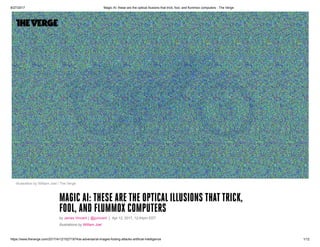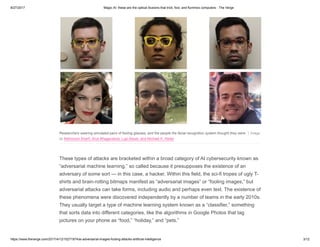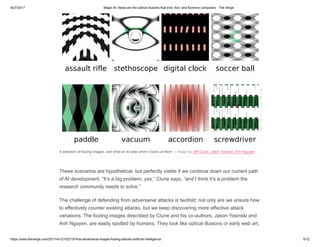Magic ai these are the optical illusions that trick, fool, and flummox computers the verge
- 1. 8/27/2017 Magic AI: these are the optical illusions that trick, fool, and flummox computers - The Verge https://www.theverge.com/2017/4/12/15271874/ai-adversarial-images-fooling-attacks-artificial-intelligence 1/12 Illustration by William Joel / The Verge MAGIC AI: THESE ARE THE OPTICAL ILLUSIONS THAT TRICK, FOOL, AND FLUMMOX COMPUTERS by James Vincent @jjvincent Apr 12, 2017, 12:04pm EDT Illustrations by William Joel
- 2. 8/27/2017 Magic AI: these are the optical illusions that trick, fool, and flummox computers - The Verge https://www.theverge.com/2017/4/12/15271874/ai-adversarial-images-fooling-attacks-artificial-intelligence 2/12 T hereŌĆÖs a scene in William GibsonŌĆÖs 2010 novel Zero History, in which a character embarking on a high-stakes raid dons what the narrator refers to as the ŌĆ£ugliest T-shirtŌĆØ in existence ŌĆö a garment which renders him invisible to CCTV. In Neal StephensonŌĆÖs Snow Crash, a bitmap image is used to transmit a virus that scrambles the brains of hackers, leaping through computer-augmented optic nerves to rot the targetŌĆÖs mind. These stories, and many others, tap into a recurring sci-fi trope: that a simple image has the power to crash computers. But the concept isnŌĆÖt fiction ŌĆö not completely, anyway. Last year, researchers were able to fool a commercial facial recognition system into thinking they were someone else just by wearing a pair of patterned glasses. A sticker overlay with a hallucinogenic print was stuck onto the frames of the specs. The twists and curves of the pattern look random to humans, but to a computer designed to pick out noses, mouths, eyes, and ears, they resembled the contours of someoneŌĆÖs face ŌĆö any face the researchers chose, in fact. These glasses wonŌĆÖt delete your presence from CCTV like GibsonŌĆÖs ugly T-shirt, but they can trick an AI into thinking youŌĆÖre the Pope. Or anyone you like.
- 3. 8/27/2017 Magic AI: these are the optical illusions that trick, fool, and flummox computers - The Verge https://www.theverge.com/2017/4/12/15271874/ai-adversarial-images-fooling-attacks-artificial-intelligence 3/12 Researchers wearing simulated pairs of fooling glasses, and the people the facial recognition system thought they were. These types of attacks are bracketed within a broad category of AI cybersecurity known as ŌĆ£adversarial machine learning,ŌĆØ so called because it presupposes the existence of an adversary of some sort ŌĆö in this case, a hacker. Within this field, the sci-fi tropes of ugly T- shirts and brain-rotting bitmaps manifest as ŌĆ£adversarial imagesŌĆØ or ŌĆ£fooling images,ŌĆØ but adversarial attacks can take forms, including audio and perhaps even text. The existence of these phenomena were discovered independently by a number of teams in the early 2010s. They usually target a type of machine learning system known as a ŌĆ£classifier,ŌĆØ something that sorts data into different categories, like the algorithms in Google Photos that tag pictures on your phone as ŌĆ£food,ŌĆØ ŌĆ£holiday,ŌĆØ and ŌĆ£pets.ŌĆØ | Image by Mahmood Sharif, Sruti Bhagavatula, Lujo Bauer, and Michael K. Reiter
- 4. 8/27/2017 Magic AI: these are the optical illusions that trick, fool, and flummox computers - The Verge https://www.theverge.com/2017/4/12/15271874/ai-adversarial-images-fooling-attacks-artificial-intelligence 4/12 To a human, a fooling image might look like a random tie-dye pattern or a burst of TV static, but show it to an AI image classifier and itŌĆÖll say with confidence: ŌĆ£Yep, thatŌĆÖs a gibbon,ŌĆØ or ŌĆ£My, what a shiny red motorbike.ŌĆØ Just as with the facial recognition system that was fooled by the psychedelic glasses, the classifier picks up visual features of the image that are so distorted a human would never recognize them. These patterns can be used in all sorts of ways to bypass AI systems, and have substantial implications for future security systems, factory robots, and self-driving cars ŌĆö all places where AIŌĆÖs ability to identify objects is crucial. ŌĆ£Imagine youŌĆÖre in the military and youŌĆÖre using a system that autonomously decides what to target,ŌĆØ Jeff Clune, co-author of a 2015 paper on fooling images, tells The Verge. ŌĆ£What you donŌĆÖt want is your enemy putting an adversarial image on top of a hospital so that you strike that hospital. Or if you are using the same system to track your enemies; you donŌĆÖt want to be easily fooled [and] start following the wrong car with your drone.ŌĆØ
- 5. 8/27/2017 Magic AI: these are the optical illusions that trick, fool, and flummox computers - The Verge https://www.theverge.com/2017/4/12/15271874/ai-adversarial-images-fooling-attacks-artificial-intelligence 5/12 A selection of fooling images, and what an AI sees when it looks at them. These scenarios are hypothetical, but perfectly viable if we continue down our current path of AI development. ŌĆ£ItŌĆÖs a big problem, yes,ŌĆØ Clune says, ŌĆ£and I think itŌĆÖs a problem the research community needs to solve.ŌĆØ The challenge of defending from adversarial attacks is twofold: not only are we unsure how to effectively counter existing attacks, but we keep discovering more effective attack variations. The fooling images described by Clune and his co-authors, Jason Yosinski and Anh Nguyen, are easily spotted by humans. They look like optical illusions or early web art, | Image by Jeff Clune, Jason Yosinski, Anh Nguyen
- 6. 8/27/2017 Magic AI: these are the optical illusions that trick, fool, and flummox computers - The Verge https://www.theverge.com/2017/4/12/15271874/ai-adversarial-images-fooling-attacks-artificial-intelligence 6/12 all blocky color and overlapping patterns, but there are far more subtle approaches to be used. One type of adversarial image ŌĆö referred to by researchers as a ŌĆ£perturbationŌĆØ ŌĆö is all but invisible to the human eye. It exists as a ripple of pixels on the surface of a photo, and can be applied to an image as easily as an Instagram filter. These perturbations were first described in 2013, and in a 2014 paper titled ŌĆ£Explaining and Harnessing Adversarial Examples,ŌĆØ researchers demonstrated how flexible they were. That pixely shimmer is capable of fooling a whole range of different classifiers, even ones it hasnŌĆÖt been trained to counter. A recently revised study named ŌĆ£Universal Adversarial PerturbationsŌĆØ made this feature explicit by successfully testing the perturbations against a number of different neural nets ŌĆö exciting a lot of researchers last month. On the left is the original image; in the middle, the perturbation; and on the right, the final, perturbed image. PERTURBATIONS CAN BE APPLIED TO PHOTOS AS EASILY AS INSTAGRAM FILTERS | Image by Ian Goodfellow, Jonathon Shlens, and Christian Szegedy
- 7. 8/27/2017 Magic AI: these are the optical illusions that trick, fool, and flummox computers - The Verge https://www.theverge.com/2017/4/12/15271874/ai-adversarial-images-fooling-attacks-artificial-intelligence 7/12 Using fooling images to hack AI systems does have its limitations: first, it takes more time to craft scrambled images in such a way that an AI system thinks itŌĆÖs seeing a specific image, rather than making a random mistake. Second, you often ŌĆö but not always ŌĆö need access to the internal code of the system youŌĆÖre trying to manipulate in order to generate the perturbation in the first place. And third, attacks arenŌĆÖt consistently effective. As shown in ŌĆ£Universal Adversarial Perturbations,ŌĆØ what fools one neural network 90 percent of the time, may only have a success rate of 50 or 60 percent on a different network. (That said, even a 50 percent error rate could be catastrophic if the classifier in question is guiding a self- driving semi truck.) To better defend AI against fooling images, engineers subject them to ŌĆ£adversarial training.ŌĆØ This involves feeding a classifier adversarial images so it can identify and ignore them, like a bouncer learning the mugshots of people banned from a bar. Unfortunately, as Nicolas Papernot, a graduate student at Pennsylvania State University whoŌĆÖs written a number of papers on adversarial attacks, explains, even this sort of training is weak against ŌĆ£computationally intensive strategiesŌĆØ (i.e, throw enough images at the system and itŌĆÖll eventually fail).
- 8. 8/27/2017 Magic AI: these are the optical illusions that trick, fool, and flummox computers - The Verge https://www.theverge.com/2017/4/12/15271874/ai-adversarial-images-fooling-attacks-artificial-intelligence 8/12 A number of images with perturbations applied to them, captioned with what the AI sees. To add to the difficulty, itŌĆÖs not always clear why certain attacks work or fail. One explanation is that adversarial images take advantage of a feature found in many AI systems known as ŌĆ£decision boundaries.ŌĆØ These boundaries are the invisible rules that dictate how a system can tell the difference between, say, a lion and a leopard. A very simple AI program that spends all its time identifying just these two animals would eventually create a mental map. Think of it as an X-Y plane: in the top right it puts all the leopards itŌĆÖs ever seen, and in the | Image by Seyed-Mohsen Moosavi- Dezfooli, Alhussein Fawzi, Omar Fawzi, Pascal Frossard
- 9. 8/27/2017 Magic AI: these are the optical illusions that trick, fool, and flummox computers - The Verge https://www.theverge.com/2017/4/12/15271874/ai-adversarial-images-fooling-attacks-artificial-intelligence 9/12 bottom left, the lions. The line dividing these two sectors ŌĆö the border at which lion becomes leopard or leopard a lion ŌĆö is known as the decision boundary. The problem with the decision boundary approach to classification, says Clune, is that itŌĆÖs too absolute, too arbitrary. ŌĆ£All youŌĆÖre doing with these networks is training them to draw lines between clusters of data rather than deeply modeling what it is to be leopard or a lion.ŌĆØ Systems like these can be manipulated in all sorts of ways by a determined adversary. To fool the lion-leopard analyzer, you could take an image of a lion and push its features to grotesque extremes, but still have it register as a normal lion: give it claws like digging equipment, paws the size of school buses, and a mane that burns like the Sun. To a human itŌĆÖs unrecognizable, but to an AI checking its decision boundary, itŌĆÖs just an extremely liony lion. As far as we know, adversarial images have never been used to cause real- world harm. But Ian Goodfellow, a research scientist at Google Brain who co-authored ŌĆ£Explaining and Harnessing Adversarial Examples,ŌĆØ says theyŌĆÖre not being ignored. ŌĆ£The research community in general, and especially Google, take this issue seriously,ŌĆØ says Goodfellow. ŌĆ£And we're working hard to develop better defenses.ŌĆØ A number of groups, like the Elon Musk-funded OpenAI, are currently conducting or soliciting research on adversarial attacks. The conclusion so far is that there is no silver bullet, but researchers disagree on how much of a threat these attacks are in the real world. There are already plenty of ways to hack self-driving cars, for example, that donŌĆÖt rely on calculating complex perturbations. Papernot says such a widespread weakness in our AI systems isnŌĆÖt a big surprise ŌĆö classifiers are trained to ŌĆ£have good average performance, but not necessarily worst-case performance ŌĆö which is typically what is sought after from a security perspective.ŌĆØ That is ŌĆ£WE'RE WORKING HARD TO DEVELOP BETTER DEFENSES.ŌĆØ
- 10. 8/27/2017 Magic AI: these are the optical illusions that trick, fool, and flummox computers - The Verge https://www.theverge.com/2017/4/12/15271874/ai-adversarial-images-fooling-attacks-artificial-intelligence 10/12 to say, researchers are less worried about the times the system fails catastrophically than how well it performs on average. One way of dealing with dodgy decision boundaries, suggests Clune, is simply to make image classifiers that more readily suggest they donŌĆÖt know what something is, as opposed to always trying to fit data into one category or another. Meanwhile, adversarial attacks also invite deeper, more conceptual speculation. The fact that the same fooling images can scramble the ŌĆ£mindsŌĆØ of AI systems developed independently by Google, Mobileye, or Facebook, reveals weaknesses that are apparently endemic to contemporary AI as a whole. ŌĆ£ItŌĆÖs like all these different networks are sitting around saying why donŌĆÖt these silly humans recognize that this static is actually a starfish,ŌĆØ says Clune. ŌĆ£That is profoundly interesting and mysterious; that all these networks are agreeing that these crazy and non-natural images are actually of the same type. That level of convergence is really surprising people.ŌĆØ For CluneŌĆÖs colleague, Jason Yosinski, the research on fooling images points to an unlikely similarity between artificial intelligence and intelligence developed by nature. He noted that the same category errors made by AI and their decision boundaries also exists in the world of zoology, where animals are tricked by what scientists call ŌĆ£supernormal stimuli.ŌĆØ These stimuli are artificial, exaggerated versions of qualities found in nature that are so enticing to animals that they override their natural instincts. This behavior was first observed around the 1950s, when researchers used it to make birds ignore their own eggs in favor of fakes with brighter colors, or to get red-bellied stickleback fish to fight pieces of trash as if they were rival males. The fish would fight trash, so long as it had a big red belly painted on it. Some people have suggested human addictions, like fast food and ŌĆ£THAT IS PROFOUNDLY INTERESTING AND MYSTERIOUS.ŌĆØ
- 11. 8/27/2017 Magic AI: these are the optical illusions that trick, fool, and flummox computers - The Verge https://www.theverge.com/2017/4/12/15271874/ai-adversarial-images-fooling-attacks-artificial-intelligence 11/12 pornography, are also examples of supernormal stimuli. In that light, one could say that the mistakes AIs are making are only natural. Unfortunately, we need them to be better than that. Ō¢Ā View all stories in Tech Apple is collecting donations for Harvey storm relief through iTunes A stu’¼Ćed bunny phone case seems like a good idea, but itŌĆÖs not very practical Hackers are using the promise of Game of Thrones spoilers to spread malware AD APPLE CIRCUIT BREAKER ENTERTAINMENT



![8/27/2017 Magic AI: these are the optical illusions that trick, fool, and flummox computers - The Verge
https://www.theverge.com/2017/4/12/15271874/ai-adversarial-images-fooling-attacks-artificial-intelligence 4/12
To a human, a fooling image might look like a random tie-dye pattern or a burst of TV static,
but show it to an AI image classifier and itŌĆÖll say with confidence: ŌĆ£Yep, thatŌĆÖs a gibbon,ŌĆØ or
ŌĆ£My, what a shiny red motorbike.ŌĆØ Just as with the facial recognition system that was fooled
by the psychedelic glasses, the classifier picks up visual features of the image that are so
distorted a human would never recognize them.
These patterns can be used in all sorts of ways to bypass AI systems, and have substantial
implications for future security systems, factory robots, and self-driving cars ŌĆö all places
where AIŌĆÖs ability to identify objects is crucial. ŌĆ£Imagine youŌĆÖre in the military and youŌĆÖre
using a system that autonomously decides what to target,ŌĆØ Jeff Clune, co-author of a 2015
paper on fooling images, tells The Verge. ŌĆ£What you donŌĆÖt want is your enemy putting an
adversarial image on top of a hospital so that you strike that hospital. Or if you are using the
same system to track your enemies; you donŌĆÖt want to be easily fooled [and] start following
the wrong car with your drone.ŌĆØ](https://image.slidesharecdn.com/magicaithesearetheopticalillusionsthattrickfoolandflummoxcomputers-theverge-171113114355/85/Magic-ai-these-are-the-optical-illusions-that-trick-fool-and-flummox-computers-the-verge-4-320.jpg)






